
Creighton Tull Chaney, known by his stage name Lon Chaney Jr., was an American actor known for playing Larry Talbot in the film The Wolf Man (1941) and its various crossovers, Count Alucard in Son of Dracula, Frankenstein's monster in The Ghost of Frankenstein (1942), the Mummy in three pictures, and various other roles in many Universal horror films, including six films in their 1940s Inner Sanctum series, making him a horror icon. He also portrayed Lennie Small in Of Mice and Men (1939) and supporting parts in dozens of mainstream movies, including High Noon (1952), The Defiant Ones (1958), and numerous Westerns, musicals, comedies and dramas.
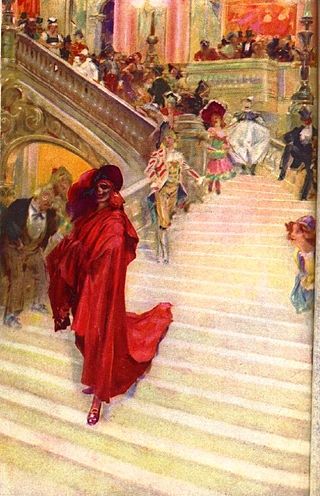
The Phantom of the Opera is a novel by French author Gaston Leroux. It was first published as a serial in Le Gaulois from 23 September 1909 to 8 January 1910, and was released in volume form in late March 1910 by Pierre Lafitte. The novel is partly inspired by historical events at the Paris Opera during the nineteenth century, and by an apocryphal tale concerning the use of a former ballet pupil's skeleton in Carl Maria von Weber's 1841 production of Der Freischütz. It has been successfully adapted into various stage and film adaptations, most notable of which are the 1925 film depiction featuring Lon Chaney, and Andrew Lloyd Webber's 1986 musical.

The Phantom of the Opera is a musical with music by Andrew Lloyd Webber, lyrics by Charles Hart, additional lyrics by Richard Stilgoe and a libretto by Lloyd Webber and Stilgoe. Based on the 1910 French novel of the same name by Gaston Leroux, it tells the tragic story of a beautiful soprano, Christine Daaé, who becomes the obsession of a mysterious, masked musical genius living in the subterranean labyrinth beneath the Paris Opéra House.
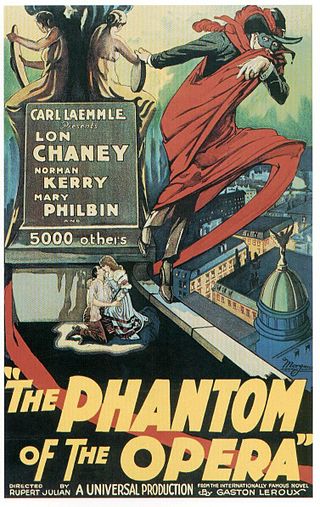
The Phantom of the Opera is a 1925 American silent horror film adaptation of Gaston Leroux's 1910 novel Le Fantôme de l'Opéra, directed by Rupert Julian and starring Lon Chaney in the title role of the deformed Phantom who haunts the Paris Opera House, causing murder and mayhem in an attempt to make the woman he loves a star. The film remains most famous for Chaney's ghastly, self-devised make-up, which was kept a studio secret until the film's premiere. The picture also features Mary Philbin, Norman Kerry, Arthur Edmund Carewe, Gibson Gowland, John St. Polis and Snitz Edwards. The last surviving cast member was Carla Laemmle, niece of producer Carl Laemmle, who played a small role as a "prima ballerina" in the film when she was about 15 years old. The film was released on September 6, 1925, premiering at the Astor Theatre in New York. The film's final budget was $632,357.
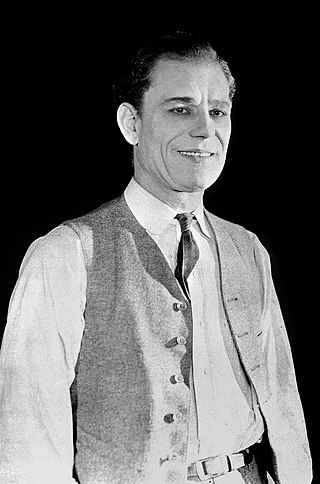
Leonidas Frank "Lon" Chaney was an American actor and makeup artist. He is regarded as one of the most versatile and powerful actors of cinema, renowned for his characterizations of tortured, often grotesque and afflicted, characters, and his groundbreaking artistry with makeup. Chaney was known for his starring roles in such silent horror films as The Hunchback of Notre Dame (1923) and The Phantom of the Opera (1925). His ability to transform himself using makeup techniques that he developed, earned him the nickname "The Man of a Thousand Faces".
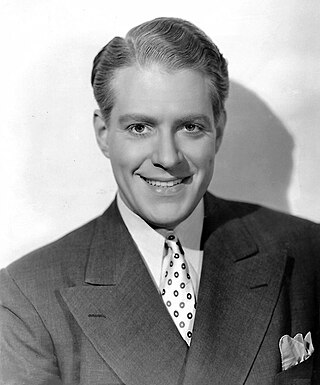
Nelson Ackerman Eddy was an American actor and baritone singer who appeared in 19 musical films during the 1930s and 1940s, as well as in opera and on the concert stage, radio, television, and in nightclubs. A classically trained baritone, he is best remembered for the eight films in which he costarred with soprano Jeanette MacDonald. He was one of the first "crossover" stars, a superstar appealing both to shrieking bobby soxers and opera purists, and in his heyday, he was the highest paid singer in the world.
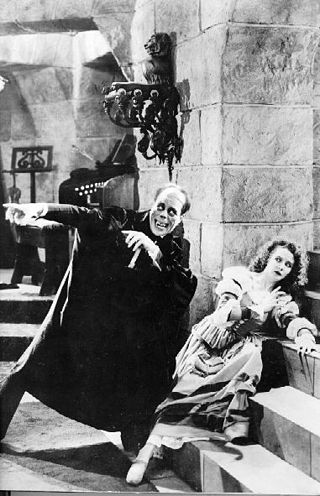
Christine Daaé is a fictional character and the female protagonist of Gaston Leroux's 1910 novel The Phantom of the Opera and of the various adaptations of the work. Erik, the Phantom of the Opera and Viscount Raoul de Chagny both fall in love with her.
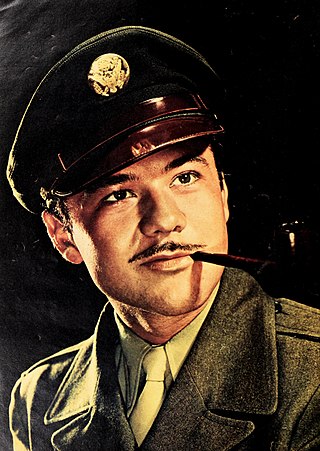
Turhan Bey was an Austrian-born actor of Turkish and Czech-Jewish origins. Active in Hollywood from 1941 to 1953, he was dubbed "The Turkish Delight" by his fans. After his return to Austria, he pursued careers as a photographer and stage director. Returning to Hollywood after a 40-year hiatus, he made several guest appearances in 1990s television series including SeaQuest DSV, Murder, She Wrote and Babylon 5 as well as a number of films. After retiring, he appeared in a number of documentaries, including a German-language documentary on his life.

The Phantom of the Opera is a 1990 American two-part television miniseries directed by Tony Richardson and starring Charles Dance in the title role. It is adapted from Arthur Kopit's book from his stage musical Phantom, which is based loosely on Gaston Leroux's 1910 novel.
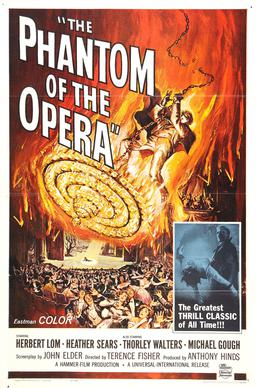
The Phantom of the Opera is a 1962 British horror film directed by Terence Fisher, a loose adaptation of the 1910 novel Le Fantôme de l'Opéra by Gaston Leroux. The film was made by Hammer Film Productions but performed unsuccessfully at the box office.

There have been many literary and dramatic works based on Gaston Leroux's 1910 novel The Phantom of the Opera, ranging from stage musicals to films to children's books. Some well known stage and screen adaptations of the novel are the 1925 film and the Andrew Lloyd Webber musical ; Susan Kay's 1990 Phantom is one of the best known novels and includes in-depth study of the title character's life and experiences.

Susanna Foster was an American film actress best known for her leading role as Christine in the 1943 film version of Phantom of the Opera.

The Climax is a horror film produced by Universal Pictures, first released in the United States in 1944. The credits state this is based on the 1909 play of the same name by Edward Locke, although the plot has little connection to Locke's play. Originally intended to be a sequel to Universal's remake of the Phantom of the Opera (1943), it featured new characters and a new plot.

Erik is the title character from Gaston Leroux's 1910 novel Le Fantôme de l'Opéra, best known to English speakers as The Phantom of the Opera. The character has been adapted to alternative media several times, including in the 1925 film adaptation starring Lon Chaney, the 1943 remake starring Claude Rains and Andrew Lloyd Webber's 1986 musical.

Arthur Lubin was an American film director and producer who directed several Abbott & Costello films, Phantom of the Opera (1943), the Francis the Talking Mule series and created the talking-horse TV series Mister Ed. A prominent director for Universal Pictures in the 1940s and 1950s, he is perhaps best known today as the man who gave Clint Eastwood his first contract in film.
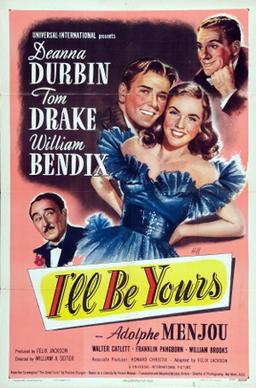
I'll Be Yours is a 1947 American musical comedy film directed by William A. Seiter and starring Deanna Durbin. Based on the play A jó tündér by Ferenc Molnár, the film is about a small-town girl who tells a fib to a wealthy businessman, which then creates complications. The play had earlier been adapted for the 1935 film The Good Fairy by Preston Sturges.

Love Never Dies is a romantic musical with music by Andrew Lloyd Webber, lyrics by Glenn Slater, and a book by Lloyd Webber, Ben Elton, Frederick Forsyth, and Slater. It is a sequel to the long-running 1986 musical The Phantom of the Opera and was loosely adapted from Forsyth's 1999 novel The Phantom of Manhattan.
The Phantom of the Opera may refer to:

Bowery to Broadway is a 1944 American film starring Maria Montez, Jack Oakie, and Susanna Foster. Donald O'Connor and Peggy Ryan also had a small specialty act, and it was the only film they were in together where they didn't have a name or character.
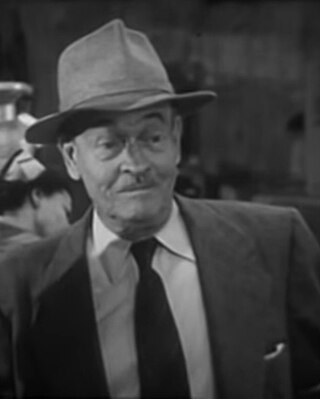
James Wheaton Chambers was an American actor during the 1930s, 1940s, and 1950s. He appeared in more than 200 films and television series during his career.





















